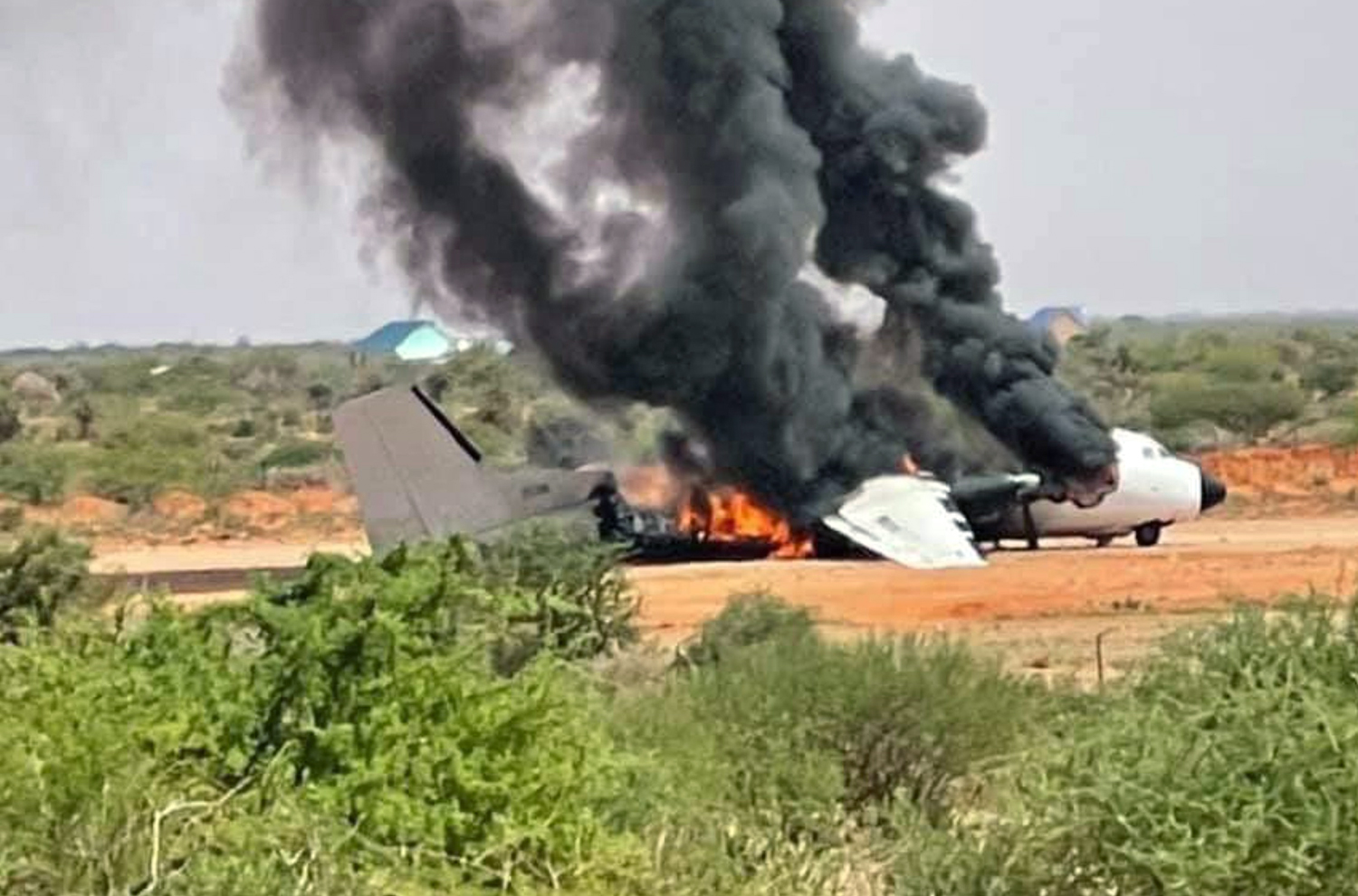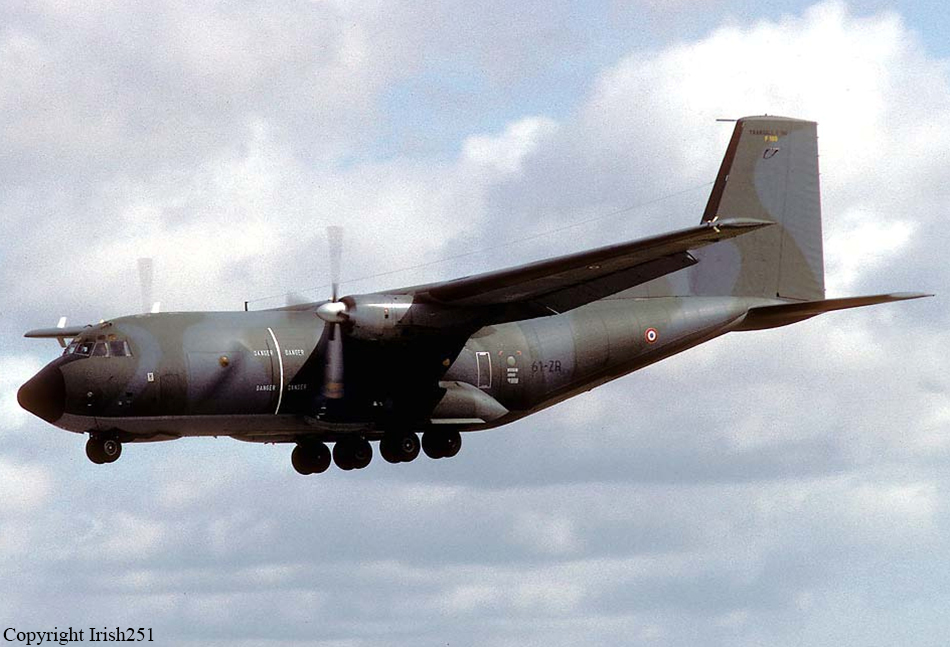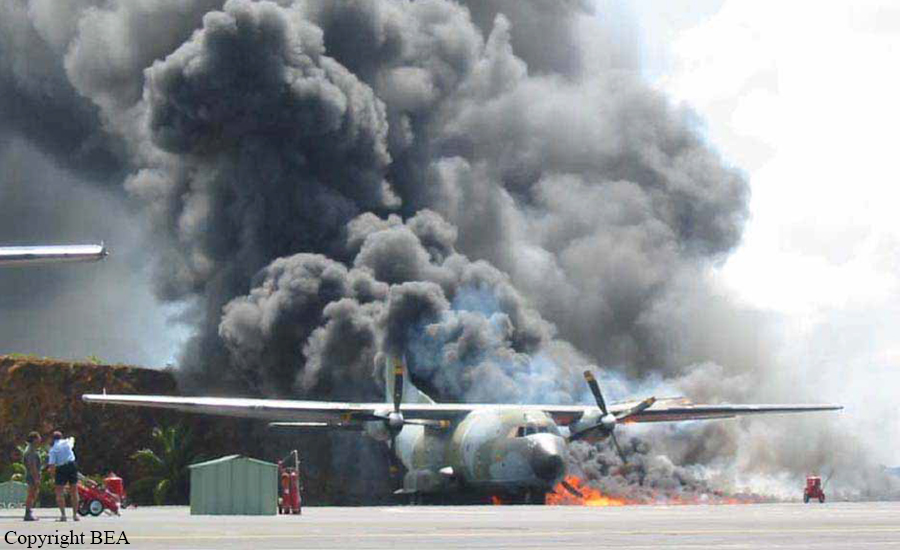Country
Crash of a Transall C-160T in Kayseri
Date & Time:
Jan 25, 2024
Registration:
69-036
Survivors:
Yes
Schedule:
Kayseri - Kayseri
MSN:
D036
YOM:
1969
Crew on board:
0
Crew fatalities:
Pax on board:
0
Pax fatalities:
Other fatalities:
Total fatalities:
0
Circumstances:
The crew was completing a local training flight at Kayseri-Erkilet Airport on behalf of the 12 Wing. While flying in the vicinity of the airport, he encountered technical problems and elected to return for an emergency landing. The crew performed a very low approach over the surrounding districts before landing on runway 25. After touchdown, the airplane apparently encountered issues with the left main gear, slid for few hundred metres then veered off runway to the left and came to rest in a grassy area. All crew members escaped uninjured.


Ground fire of a Transall C-160NG in Dolow
Date & Time:
Nov 3, 2021
Registration:
EY-360
Survivors:
Yes
Schedule:
Mogadishu - Dolow
MSN:
F233
YOM:
1985
Crew on board:
2
Crew fatalities:
Pax on board:
0
Pax fatalities:
Other fatalities:
Total fatalities:
0
Circumstances:
The crew was completing a cargo flight from Mogadishu to Dolow. After landing, the crew stopped the aircraft on the runway and was able to evacuate the cabin before the aircraft would be partially destroyed by fire.

Crash of Transall C-160D at Wunstorf AFB
Date & Time:
Sep 22, 2008
Registration:
50+50
Survivors:
Yes
MSN:
D72
Crew on board:
0
Crew fatalities:
Pax on board:
0
Pax fatalities:
Other fatalities:
Total fatalities:
0
Circumstances:
The crew was performing a training flight in the region of Hanover. While flying at low altitude in the area of Frielendorf, passing from IFR to VFR mode, the aircraft collided with trees. The crew diverted to Wunstorf AFB where he landed safely. All occupants escaped uninjured while the aircraft was damaged beyond repair due to serious damages to tail and stabilizers.

Ground fire of a Transall C-160NG in Wamena
Date & Time:
Mar 6, 2008 at 0920 LT
Registration:
PK-VTQ
Survivors:
Yes
Schedule:
Jayapura – Wamena
MSN:
F235
YOM:
1985
Crew on board:
7
Crew fatalities:
Pax on board:
0
Pax fatalities:
Other fatalities:
Total fatalities:
0
Circumstances:
On 6 March 2008, a Transall C-160 aircraft, registered PK-VTQ, operated by PT. Manunggal Air, was on an unscheduled freight flight from Sentani Airport, Jayapura, to Wamena Airport, Papua. There were seven people on board; two pilots, two engineers, and three flight officers. The pilots reported that the approach and landing were normal. However, they told the investigators that both Beta lights did not illuminate during the landing roll, so they could not use reverse thrust. They reported that they used maximum brakes to slow the aircraft, and rolled through to the end of runway 15. During the 180-degree right turn at the end of the runway, they felt the left brakes grabbing, and had to use increased thrust on the left engine to assist the turn. After completing the turn, the pilots backtracked the aircraft towards taxiway “E”, about 450 meters from the departure end of runway 15. The air traffic controller informed the Transall crew that heavy smoke was coming from the left main wheels, and that they should proceed to taxiway “E” and stop on the taxiway. Before the aircraft entered taxiway “E”, the controller activated the crash alarm. The pilots stopped the aircraft on taxiway “E”, and the occupants disembarked and attempted to extinguish the wheel-bay fire with a hand held extinguisher. The airport rescue fire fighting service (RFFS) arrived at the aircraft 10 minutes after the aircraft came to a stop on taxiway “E”. It took a further 5 minutes to commence applying foam. The attempts to extinguish the fire were unsuccessful, and the fire destroyed the aircraft and its cargo of fuel in drums. Investigators found molten metal on the runway along the left wheel track for about 16 meters, about 100 meters from taxiway “E”, between taxiway “E” and the departure end of runway 15. There was also molten metal along the left wheel track on taxiway “E”.
Probable cause:
The aircraft’s left main wheels’ brakes overheated during the landing roll and a fire commenced in the brake assembly of one or more of the left main landing gear wheels. The evidence indicated that a brake cylinder and/or hydraulic line may have failed. It is likely that brake system hydraulic fluid under pressure, was the propellant that fed the fire. There was no Emergency Response Plan at Wamena. The RFFS delay in applying fire suppressant resulted in the fire engulfing the aircraft.
Final Report:







Ground fire of a Transall C-160 in Fort-de-France
Date & Time:
May 6, 2004 at 1358 LT
Registration:
R100/F-RAZR
Survivors:
Yes
Schedule:
Fort-de-France - Fort-de-France
MSN:
F100
YOM:
1970
Crew on board:
8
Crew fatalities:
Pax on board:
0
Pax fatalities:
Other fatalities:
Total fatalities:
0
Aircraft flight hours:
18530
Circumstances:
The aircraft was engaged in a local post maintenance test flight at Fort-de-France-Le Lamentin Airport, carrying five technicians and three crew members on behalf of the Escadron de Transport Outremer 58. After engine startup, the crew started to taxi when a fire erupted. The aircraft was stopped on the ramp and all eight occupants escaped uninjured. Within three minutes, fire bombers were on site and extinguished the fire. Nevertheless, the aircraft was damaged beyond repair.
Probable cause:
The accident was caused by electrical arcing at the power cable to a submersible fuel pump. This arcing occurred above the kerosene liquid inside the tank full of fuel vapors. The cable type used was chosen at the time of the design of the aircraft. Atmospheric conditions on the apron of Fort de France have raised the temperature of the reservoir beyond the flash point kerosene. The vapors contained in this tank were explosive, and the arc was enough to initiate the blast. As such, atmospheric conditions are a certain cause of environmental origin of the accident. The appearance of the arc is, in turn, has only technical causes:
- The quality of cable used and age are in fact responsible for the creation of the electric arc.
- The formation of the insulating sheath of this type of cable is not likely to ensure an absolute seal. This quality is also not claimed by its manufacturer.
Indeed, the analysis carried out show a porosity of electrical cable, even nine, therefore that it is soaked in kerosene. The presence of kerosene increases the phenomenon of porosity of old cables. Degradation characteristics of dielectric strength of the cable insulation explains the appearance of the arc. The accident occurred while the cable was over 19 years old. The fuel pumps wiring has never been a problem. But there has not been a cable that had reached the age of 19 years. The aging of the cable could still degrade the seal. Finally, maintaining this type of cable on the first C160 series until this accident was part of a complex process in which traceability has not been formally established. Doubts indeed appeared in 1969 on the quality of these cables, doubts that can be considered today as precursors. Measures had been adopted precisely to overcome these deficiencies. In this regard, the replacement of the fuel pump wiring of the second series C 160 of these cables with a newer type and considered more efficient is particularly significant. Its extension to the first series aircraft might have seemed relevant, and would probably have prevented the accident. The reasons which led to the maintenance of such cables on the C 160 series first held in both the human factor (underestimation of risk, lack of global view on the issue) and organizational factors, which can be seen as a lack of traceability of technical and logistic actions, a lack of consistency of the measures adopted, and probable deficiencies in the information flow.
- The quality of cable used and age are in fact responsible for the creation of the electric arc.
- The formation of the insulating sheath of this type of cable is not likely to ensure an absolute seal. This quality is also not claimed by its manufacturer.
Indeed, the analysis carried out show a porosity of electrical cable, even nine, therefore that it is soaked in kerosene. The presence of kerosene increases the phenomenon of porosity of old cables. Degradation characteristics of dielectric strength of the cable insulation explains the appearance of the arc. The accident occurred while the cable was over 19 years old. The fuel pumps wiring has never been a problem. But there has not been a cable that had reached the age of 19 years. The aging of the cable could still degrade the seal. Finally, maintaining this type of cable on the first C160 series until this accident was part of a complex process in which traceability has not been formally established. Doubts indeed appeared in 1969 on the quality of these cables, doubts that can be considered today as precursors. Measures had been adopted precisely to overcome these deficiencies. In this regard, the replacement of the fuel pump wiring of the second series C 160 of these cables with a newer type and considered more efficient is particularly significant. Its extension to the first series aircraft might have seemed relevant, and would probably have prevented the accident. The reasons which led to the maintenance of such cables on the C 160 series first held in both the human factor (underestimation of risk, lack of global view on the issue) and organizational factors, which can be seen as a lack of traceability of technical and logistic actions, a lack of consistency of the measures adopted, and probable deficiencies in the information flow.
Final Report:






